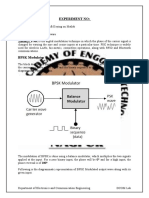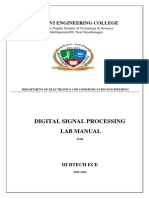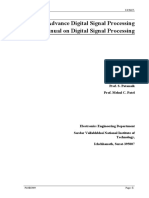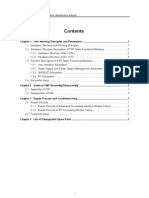Objective: Write A MATLAB Program To Determine The Free Space Path Loss and Power Received by Antenna
Objective: Write A MATLAB Program To Determine The Free Space Path Loss and Power Received by Antenna
Uploaded by
NIRAJ KUMAR SinghCopyright:
Available Formats
Objective: Write A MATLAB Program To Determine The Free Space Path Loss and Power Received by Antenna
Objective: Write A MATLAB Program To Determine The Free Space Path Loss and Power Received by Antenna
Uploaded by
NIRAJ KUMAR SinghOriginal Description:
Original Title
Copyright
Available Formats
Share this document
Did you find this document useful?
Is this content inappropriate?
Copyright:
Available Formats
Objective: Write A MATLAB Program To Determine The Free Space Path Loss and Power Received by Antenna
Objective: Write A MATLAB Program To Determine The Free Space Path Loss and Power Received by Antenna
Uploaded by
NIRAJ KUMAR SinghCopyright:
Available Formats
CE00036-3-Data Communication Systems Individual Assignment Page 1 of 9
Q2. Write a MATLAB program to determine the free space path loss and power received by
antenna.
OBJECTIVE
The main objective of this experiment is to write a MATLAB program to determine the free
space path loss and power received by antenna.
THEORY
Free-space path loss (FSPL) is the loss in signal strength of an electromagnetic wave that
would result from a line-of-sight path through free space, with no obstacles nearby to cause
reflection or diffraction.
Calculation of free-space path loss
The expression for FSPL actually encapsulates two effects. Free-space power loss is
proportional to the square of the distance between the transmitter and receiver, and also
proportional to the square of the frequency of the radio signal. Firstly, the spreading out of
electromagnetic energy in free space is determined by the inverse square law
1
Signal= ..(Eqn .1)
distance 2
Thus, the formula for free space path loss is given by
4 d
FSPL=
Effect of antenna gain on path loss equation
The free space path loss equation above does not include any component for antenna gains. It
is assumed that the antenna gain is unity for both the transmitter. In reality, though, all
antennas will have a certain amount of gain and this will affect the overall signal level. Any
antenna gain will reduce the "loss" when compared to a unity gain system.
Level 3 Asia Pacific Institute of Information Technology 2017
CE00036-3-Data Communication Systems Individual Assignment Page 2 of 9
ALGORITHM
Before writing the matlab code in matlab software, the following steps is required before
which is mentioned below accordingly.
Step 1: Open the matlab software by double click on the icon of matlab on the d
Step2: Open the editor window.
Step3: Write the matlab code for finding the free space path loss and power received
Step 4: Save the matlab file.
Step 5: Run the matlab file and observed the result
Step 6: If there is an error then remove the error and again run the matlab file until the output wil
MATLAB CODE
clc;
clear all;
close all;
D=0:0.1:10
F=input('Frequency in MHz');
Pt=input('Transmitted power');
Gt=input('Gain of transmitter antenna');
Gs=input('Gain of reciever antenna');
FSPL=20*log10(D)+ 20*log10(F)+ 32.44
Pr=Pt+Gt+Gs-FSPL
Level 3 Asia Pacific Institute of Information Technology 2017
CE00036-3-Data Communication Systems Individual Assignment Page 3 of 9
plot(D,Pr)
title('Free Signal Path Loss');
xlabel('D');
ylabel('Pr');
MATLAB RESULT
After running the Matlab code the below graph and parameters value has been obtained
Fig 1: Graph of free signal path loss
Frequency in MHz 15
Transmitted power 35
Gain of transmitter antenna 75
Gain of receiver antenna 65
CONCLUSION
After completion of this experiment the concept of calculation of free space path loss and
effects of antenna gain on path loss equation has been known and the value of the parameters
like frequency, transmitted power, gain of transmitter antenna and receiver antenna has been
obtained directly by using the Matlab software by writing the Matlab code in the editor
window.
Level 3 Asia Pacific Institute of Information Technology 2017
CE00036-3-Data Communication Systems Individual Assignment Page 4 of 9
Q3. Write a MATLAB code for ASK & FSK digital modulation schemes.
OBJECTIVE
The main objective of this experiment is to write a MATLAB code for ASK & FSK digital
modulation schemes.
THEORY
There are three basic ways to modulate a sine wave radio carrier: modifying the amplitude,
frequency, or phase. More sophisticated methods combine two or more of these variations to
improve spectral efficiency. These basic modulation forms are still used today with digital
signals.
AKS:
Amplitude-shift keying (ASK) is a kind of digital modulation that represents digital data as
variations in the amplitude of a carrier wave. The amplitude of an analog carrier signal varies
in accordance with the bit stream (modulating signal) where frequency and phase
are keeping constant. The level of amplitude can be used to represent binary logic 0s and 1s.
We can think of a carrier signal as an ON or OFF switch. In the modulated signal, logic 0 is
represented by the absence of a carrier, thus giving OFF/ON keying operation and hence the
name given.
Figure 2
FSK:
Frequency Shift Keying (FSK) is the digital modulation technique in which the frequency of
the carrier signal varies according to the digital signal changes. FSK is a scheme of
frequency modulation.
Level 3 Asia Pacific Institute of Information Technology 2017
CE00036-3-Data Communication Systems Individual Assignment Page 5 of 9
The output of a FSK modulated wave is high in frequency for a binary High input and is low
in frequency for a binary Low input. The binary 1s and 0s are called Mark and Space
frequencies.
The following image is the diagrammatic representation of FSK modulated waveform along
with its input.
Figure 3
ALGORITHM
Before writing the Matlab code in Matlab software, the following steps is required before
which is mentioned below accordingly
Step 1: Open the matlab software by double click on the icon of matlab on the d
Step2: Open the editor window.
Step3: Write the matlab code for finding the free space path loss and power received
Step 4: Save the matlab file.
Step 5: Run the matlab file and observed the result
Step 6: If there is an error then remove the error and again run the matlab file until the output wil
Level 3 Asia Pacific Institute of Information Technology 2017
CE00036-3-Data Communication Systems Individual Assignment Page 6 of 9
MATLAB CODE
For ASK:
clc;
clear all;
close all;
Fc=input('Enter Carrier Frequency = ')
Fi=input('Enter input Frequency = ')
A=4;
t=0:0.0001:1;
c=A*cos(2*pi*Fc*t);
subplot(3,1,1)
plot(t,c)
M=(A/2)*square(2*pi*Fi*t)+A/2;
subplot(3,1,2)
plot(t,M)
ask=c.*M;
subplot(3,1,3)
plot(t,ask)
For FSK:
clc
close all
clear all
fc1=input('Enter the freq of 1st Sine Wave carrier:');
fc2=input('Enter the freq of 2nd Sine Wave carrier:');
fp=input('Enter the freq of Periodic Binary pulse (Message):');
amp=input('Enter the amplitude (For Both Carrier & Binary Pulse Message):');
amp=amp/2;
t=0:0.001:1;
c1=amp.*sin(2*pi*fc1*t);
c2=amp.*sin(2*pi*fc2*t);
subplot(4,1,1);
plot(t,c1)
xlabel('Time')
ylabel('Amplitude')
title('Carrier 1 Wave')
subplot(4,1,2)
plot(t,c2)
xlabel('Time')
ylabel('Amplitude')
title('Carrier 2 Wave')
m=amp.*square(2*pi*fp*t)+amp;
subplot(4,1,3)
Level 3 Asia Pacific Institute of Information Technology 2017
CE00036-3-Data Communication Systems Individual Assignment Page 7 of 9
plot(t,m)
xlabel('Time')
ylabel('Amplitude')
title('Binary Message Pulses')
for i=0:1000
if m(i+1)==0
mm(i+1)=c2(i+1);
else
mm(i+1)=c1(i+1);
end
end
subplot(4,1,4)
plot(t,mm)
xlabel('Time')
ylabel('Amplitude')
title('Modulated Wave')
MATLAB RESULT
After running the matlab code the below graph and parameters value has been obtained
For ASK:
Figure 4: Matlab result of ASK
Level 3 Asia Pacific Institute of Information Technology 2017
CE00036-3-Data Communication Systems Individual Assignment Page 8 of 9
Carrier Frequency(Fc) = 50
Input Frequency(Fi) = 30
For FSK:
Figure 5: Matlab result of FSK
1st sin wave carrier = 50
2nd sin wave carrier = 45
Periodic binary pulse = 20
Amplitude = 10
CONCLUSION
The short form of Amplitude Shift Keying is referred as ASK. It is the digital modulation
technique. In this technique, amplitude of the RF carrier is varied in accordance with
baseband digital input signal.
The short form of Frequency Shift Keying is referred as FSK. It is also digital modulation
technique. In this technique, frequency of the RF carrier is varied in accordance with
baseband digital input.
Level 3 Asia Pacific Institute of Information Technology 2017
CE00036-3-Data Communication Systems Individual Assignment Page 9 of 9
Q4. The main of the experiment is to write a MATLAB program for TDM function also to
plot the graph for the following function.
In order to utilize common transmission channel to transmit multiple signals at a time
multiplexing is used. Time Division Multiplexing is one of the method which is generally
employed. In this method all the signals to be transmitted are not transmitted simultaneously,
instead they are transmitted one by one, each signal is transmitted for a very short time. When
all the signals are transmitted once on the transmission channel, one frame is said to be
completed.
The above figure shows the frame of TDM signal. For three inputs being multiplexed, a
frame of TDM will consists of three units i.e., one unit from each source. Hence, for n
number of inputs, each frames will consist of n units.
The TDM system is suitable for multiplex both analog and digital signals, however it is more
suitable for the digital multiplexing. The signalling rate of TDM system is defined as the
number of pulses transmitted per sec.
Advantages of TDM: -
i) Full available channel bandwidth can be utilized for each channel.
ii) TDM Circuitry is simple.
iii) The problem of crosstalk is not severe.
Level 3 Asia Pacific Institute of Information Technology 2017
You might also like
- Digital Modulations using MatlabFrom EverandDigital Modulations using MatlabRating: 4 out of 5 stars4/5 (6)
- VZ-30 Service ManualDocument32 pagesVZ-30 Service ManualJimmy Mayta100% (2)
- PSK Lab ManualDocument4 pagesPSK Lab ManualSakshi DewadeNo ratings yet
- Simulation of Digital Communication Systems Using MatlabFrom EverandSimulation of Digital Communication Systems Using MatlabRating: 3.5 out of 5 stars3.5/5 (22)
- Amplitude Shift Keying in MATLAB: Technological Institute of The PhilippinesDocument9 pagesAmplitude Shift Keying in MATLAB: Technological Institute of The PhilippineskennethNo ratings yet
- Lets Discuss (How, What and Why) : 16 QAM Simulation in MATLABDocument7 pagesLets Discuss (How, What and Why) : 16 QAM Simulation in MATLABpreetik917No ratings yet
- Module 3 - Lab-3Document4 pagesModule 3 - Lab-3مبنيةنميب نتمبيةنNo ratings yet
- DSP Lab Manual PallaviDocument67 pagesDSP Lab Manual Pallavib vamshi100% (1)
- Exp. No.11 Simulation of M-Ary Ask, FSK and PSK Aim:: CommstartupDocument3 pagesExp. No.11 Simulation of M-Ary Ask, FSK and PSK Aim:: CommstartupShathis KumarNo ratings yet
- FISACDocument5 pagesFISACshravanibhor3084No ratings yet
- Experiment # 3 Amplitude Modulation and Demodulation: 1 PurposeDocument9 pagesExperiment # 3 Amplitude Modulation and Demodulation: 1 PurposeGeorgeNo ratings yet
- DCOM Lab Manual 18-19 - EvenDocument27 pagesDCOM Lab Manual 18-19 - EvenAbhishek ResourceNo ratings yet
- PAPR Reduction of An MC-CDMA System Using SLM Technique: Gagandeep Kaur, Rajbir KaurDocument5 pagesPAPR Reduction of An MC-CDMA System Using SLM Technique: Gagandeep Kaur, Rajbir KaurIjarcet JournalNo ratings yet
- ADC LabsDocument19 pagesADC LabsJAVED AKHTAR REG.2020 UET NFC FD ELECT 76.No ratings yet
- SPlabDocument34 pagesSPlabLRani LoganathanNo ratings yet
- DSP Lab Manual-Msc2Document103 pagesDSP Lab Manual-Msc2AswathyPrasadNo ratings yet
- Birla Vishwakarma Mahavidyalaya Engineering College: Department of Electronics & Communication Laboratory ManualDocument13 pagesBirla Vishwakarma Mahavidyalaya Engineering College: Department of Electronics & Communication Laboratory ManualYASH BHAVSARNo ratings yet
- Software-Defined Radio Lab 2: Data Modulation and TransmissionDocument8 pagesSoftware-Defined Radio Lab 2: Data Modulation and TransmissionpaulCGNo ratings yet
- Lab ExperimentDocument14 pagesLab ExperimentRashid KhurshidNo ratings yet
- DSP - Manual PartDocument12 pagesDSP - Manual PartShivani AgarwalNo ratings yet
- Simulation of A CDMA Systems Using Linear Prediction and MUD (Matlab)Document44 pagesSimulation of A CDMA Systems Using Linear Prediction and MUD (Matlab)Raj Kumar100% (2)
- DC Lab Manual Simulation ExperimentsDocument29 pagesDC Lab Manual Simulation Experimentsrobinmyow211No ratings yet
- IV-1 DSP Lab ManualDocument123 pagesIV-1 DSP Lab ManualVijayalaxmi Biradar100% (15)
- Digital Signal Processing Lab Work (TEC-317) : NAME: Samyak I.D.: 53589Document24 pagesDigital Signal Processing Lab Work (TEC-317) : NAME: Samyak I.D.: 53589Coolest SamyakNo ratings yet
- Digital Communication Systems: ECE-4001 TASK-3Document12 pagesDigital Communication Systems: ECE-4001 TASK-3Aniket SaxenaNo ratings yet
- DSP Lab Manual: 5 Semester Electronics and Communication Subject Code: 18ecl57 2020-21Document58 pagesDSP Lab Manual: 5 Semester Electronics and Communication Subject Code: 18ecl57 2020-21Axis AlexNo ratings yet
- Ec 3501 Wirelss Communication Lab ManualDocument34 pagesEc 3501 Wirelss Communication Lab ManualperiyasamyNo ratings yet
- Digital Signal Processing: Lab ManualDocument13 pagesDigital Signal Processing: Lab ManualUbaid Ur RahmanNo ratings yet
- Experiment 7 - 2FSKDocument8 pagesExperiment 7 - 2FSKHussain Ageel NaseerNo ratings yet
- WC Lab MannualDocument78 pagesWC Lab MannualJashwanth SatyaNo ratings yet
- Software Lab II (1)Document29 pagesSoftware Lab II (1)bhargavaanita91No ratings yet
- Communication Systems Ii - LabmanualDocument12 pagesCommunication Systems Ii - LabmanualpramodNo ratings yet
- Analog Communication Lab New Final 30sep2021Document76 pagesAnalog Communication Lab New Final 30sep2021jaivikpatel1122No ratings yet
- Digital Communication Systems: ECE-4001 TASK-3Document11 pagesDigital Communication Systems: ECE-4001 TASK-3Aniket SaxenaNo ratings yet
- EC106 Advance Digital Signal Processing Lab Manual On Digital Signal ProcessingDocument69 pagesEC106 Advance Digital Signal Processing Lab Manual On Digital Signal ProcessingSHARAD FADADU0% (1)
- Do Cum en To 10348Document14 pagesDo Cum en To 10348Abdul KaderNo ratings yet
- Lab1FA11 PDFDocument11 pagesLab1FA11 PDFaxecaleverNo ratings yet
- ModulationPaper ACIQR-3Document85 pagesModulationPaper ACIQR-3Ryan AnchetaNo ratings yet
- DSP Lab Report1Document42 pagesDSP Lab Report1Coolest SamyakNo ratings yet
- Soft Lab - Iii Ec506Document34 pagesSoft Lab - Iii Ec506Akanksha DixitNo ratings yet
- Department of Electrical Engineering Communication SystemsDocument7 pagesDepartment of Electrical Engineering Communication SystemsBasharat AslamNo ratings yet
- DSP Lab Manual For ECE 3 2 R09Document147 pagesDSP Lab Manual For ECE 3 2 R09Jandfor Tansfg Errott100% (2)
- Matlab Simulation of DVB-H Transmission Under Different Transmission ConditionsDocument7 pagesMatlab Simulation of DVB-H Transmission Under Different Transmission ConditionsArisena ArganNo ratings yet
- Lab4: Sampling and Quantization of Audio Signal in MatlabDocument9 pagesLab4: Sampling and Quantization of Audio Signal in MatlabRabail InKredibl100% (1)
- Lab DCT AssignmentDocument2 pagesLab DCT AssignmentMNo ratings yet
- Efficient Implementation of 16-Bit Multiplier-Accumulator Using Radix-2 Modified Booth Algorithm and SPST Adder Using VerilogDocument12 pagesEfficient Implementation of 16-Bit Multiplier-Accumulator Using Radix-2 Modified Booth Algorithm and SPST Adder Using VerilogAnonymous e4UpOQEPNo ratings yet
- SDS Laboratory Manual1Document29 pagesSDS Laboratory Manual1hardiknasa.hnNo ratings yet
- CSPII Lab InstructionsDocument8 pagesCSPII Lab InstructionsSadiqur Rahaman SumonNo ratings yet
- Digital CommunicationDocument56 pagesDigital CommunicationGeorge HegelNo ratings yet
- Analog Communication Lab New Final 30sep2021Document75 pagesAnalog Communication Lab New Final 30sep20212023uec1833No ratings yet
- Cycle 2 Adc 18tel67Document31 pagesCycle 2 Adc 18tel67LitlatohNo ratings yet
- Cmos Design of A Multi - Input Analog Multiplier and Divider Circuit (#117087) - 99305Document8 pagesCmos Design of A Multi - Input Analog Multiplier and Divider Circuit (#117087) - 99305Khiêm LêNo ratings yet
- LMS Adaptive FilterDocument11 pagesLMS Adaptive FilterNandakumar SamyNo ratings yet
- Lab 3 ౼ Communication Systems Simulation Using MATLAB: 1. Before the StartDocument5 pagesLab 3 ౼ Communication Systems Simulation Using MATLAB: 1. Before the StartKishore KrishnanNo ratings yet
- Lab 3 ౼ Communication Systems Simulation Using MATLABDocument5 pagesLab 3 ౼ Communication Systems Simulation Using MATLABmaenfadelNo ratings yet
- EE115IU_Lab5Document7 pagesEE115IU_Lab5vinhhoang140403glNo ratings yet
- Simple Vibration Problems With MATLAB (And Some Help From MAPLE)Document170 pagesSimple Vibration Problems With MATLAB (And Some Help From MAPLE)megustalazorraNo ratings yet
- Programming Your GPU with OpenMP: Performance Portability for GPUsFrom EverandProgramming Your GPU with OpenMP: Performance Portability for GPUsNo ratings yet
- The Elements of Computing Systems, second edition: Building a Modern Computer from First PrinciplesFrom EverandThe Elements of Computing Systems, second edition: Building a Modern Computer from First PrinciplesNo ratings yet
- Analytical Modeling of Wireless Communication SystemsFrom EverandAnalytical Modeling of Wireless Communication SystemsNo ratings yet
- El2.e - 001Document2 pagesEl2.e - 001kamalNo ratings yet
- Wideband TV White Space Transceiver Design and ImplementationDocument7 pagesWideband TV White Space Transceiver Design and ImplementationAnghye PlataNo ratings yet
- Baseband and Passband Data 2. Baseband and Passband Data Transmissions (Contin.)Document7 pagesBaseband and Passband Data 2. Baseband and Passband Data Transmissions (Contin.)ati atiNo ratings yet
- RF Architectures & Digital Signal Processing Aspects of Digital Wireless TransceiversDocument20 pagesRF Architectures & Digital Signal Processing Aspects of Digital Wireless TransceiversCassio Jose FonsecaNo ratings yet
- Lecture 1Document19 pagesLecture 1uckyourabbitNo ratings yet
- 1-BTS3900 V100R010C10SPC255 Upgrade Guide (SME-based) (Recommended)Document124 pages1-BTS3900 V100R010C10SPC255 Upgrade Guide (SME-based) (Recommended)GauravSwamiNo ratings yet
- Chapter 3Document50 pagesChapter 3abrhamgetachew99No ratings yet
- Wireless Design Seminar 2006Document237 pagesWireless Design Seminar 2006wagnalang1639No ratings yet
- WDT, USB and LMT Commisioning L1 Troubleshooting GuidanceDocument55 pagesWDT, USB and LMT Commisioning L1 Troubleshooting GuidanceDolly StevenNo ratings yet
- Ge Et Al-2016-Wireless Communications and Mobile ComputingDocument13 pagesGe Et Al-2016-Wireless Communications and Mobile ComputingStefana SofianNo ratings yet
- ETS1201 Series Fixed Wireless Terminal Maintenance ManualDocument34 pagesETS1201 Series Fixed Wireless Terminal Maintenance ManualRumesha TharindiNo ratings yet
- Wireless Communications Lab: Robert W. Heath Jr. PH.D, P.E. Ke5NcgDocument42 pagesWireless Communications Lab: Robert W. Heath Jr. PH.D, P.E. Ke5Ncgdevesh kumarNo ratings yet
- BOQ - Indoor PartDocument4 pagesBOQ - Indoor Partwafa wafaNo ratings yet
- BandwidthDocument25 pagesBandwidthlvsaruNo ratings yet
- Query PA Information-20161223-154844Document15 pagesQuery PA Information-20161223-154844fkkgđkjkNo ratings yet
- Digital Signal Processing For Deep Space TransponderDocument6 pagesDigital Signal Processing For Deep Space TransponderSatish KapalavayiNo ratings yet
- 68420378764Document3 pages68420378764ZanNo ratings yet
- (For Customer) RRU5512f Hardware Description (Draft A, Global-Restricted) (...Document24 pages(For Customer) RRU5512f Hardware Description (Draft A, Global-Restricted) (...pozdroNo ratings yet
- Digital Data TransmissionDocument45 pagesDigital Data Transmissionneelima raniNo ratings yet
- Figure 1.1 A Block Diagram of A Communication SystemsDocument14 pagesFigure 1.1 A Block Diagram of A Communication SystemsJulia JosephNo ratings yet
- Lecture Notes 6 5510Document55 pagesLecture Notes 6 5510Chentao YueNo ratings yet
- ADC Unit - 1 R20-1Document146 pagesADC Unit - 1 R20-1NeelimaNo ratings yet
- Digital Microwave Communication PrinciplesDocument113 pagesDigital Microwave Communication Principleskaz7878No ratings yet
- Doordarshan ReportDocument18 pagesDoordarshan ReportSajal DasNo ratings yet
- Microwave Link Design SampleDocument76 pagesMicrowave Link Design Samplesuz_5100% (2)
- Review On FM0/Manchester Encoder-Decoder Used in DSRC Based ApplicationsDocument4 pagesReview On FM0/Manchester Encoder-Decoder Used in DSRC Based ApplicationsEditor IJRITCCNo ratings yet
- A Low-Power 60-GHz CMOS Transceiver For WiGig Applications PDFDocument2 pagesA Low-Power 60-GHz CMOS Transceiver For WiGig Applications PDFdanial_1234No ratings yet
- Chapter 5 - Analog - TransmissionDocument6 pagesChapter 5 - Analog - TransmissionMd Saidur Rahman Kohinoor92% (86)
- Lecture 5 Baseband and Passband - PPTX - Annotatedday2Document57 pagesLecture 5 Baseband and Passband - PPTX - Annotatedday2sainarayanasujitNo ratings yet

























































































